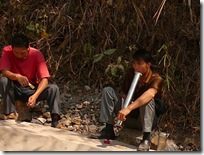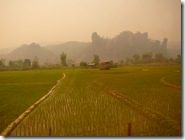Same Same…But Different
I don’t know why but, for some reason, when I cross a border I somehow expect everything to change dramatically right away. Shouldn’t the landscape, the people and maybe even the weather be different? I mean we’re in a different country for crying out loud!
I guess it’s because, previously, when I’ve crossed into a different country it’s been by plane and the distances have been huge and so, therefore, are the differences. Crossing borders by bus is much less dramatic, the changes are subtler, and it takes time for the differences to sink in.
And so it was with Laos as we crossed over from Thailand. The two countries share a border, part of their history and some of their culture. On the surface they can appear very similar, but it doesn’t take very long to realize that they are same, same…but different.
 The landscape is definitely similar. After spending so much time in northern Thailand we could easily see that northern Laos looked the same. It was the getting around in that landscape that was different. The roads in Thailand were surprisingly good – even the route to some of the smaller, out-of-the-way, places we visited were very good, wide, paved roads and the buses would stop regularly for meal and pee breaks. The same cannot be said of Laos. Most of the roads we have traveled on are broken up, twisty and windy, making for a bumpy, dusty, uncomfortable ride. And the pee breaks happened when the driver needed to go…he would just stop the bus and we would all
The landscape is definitely similar. After spending so much time in northern Thailand we could easily see that northern Laos looked the same. It was the getting around in that landscape that was different. The roads in Thailand were surprisingly good – even the route to some of the smaller, out-of-the-way, places we visited were very good, wide, paved roads and the buses would stop regularly for meal and pee breaks. The same cannot be said of Laos. Most of the roads we have traveled on are broken up, twisty and windy, making for a bumpy, dusty, uncomfortable ride. And the pee breaks happened when the driver needed to go…he would just stop the bus and we would all  pile out and find a cubby hole in the roadside brush to drop our drawers (as a side note, I have no idea how Laos women manage to pee out in the open showing great modesty and not peeing on their clothes…I can only manage one, or the other). There is a lot of work happening to improve the roads but the labor is manual and the Laos are famously laid-back so progress is slow. We saw this worker on the side of the road, taking a break and smoking his bong…three guesses as to what was in it in this opium rich area of the world.
pile out and find a cubby hole in the roadside brush to drop our drawers (as a side note, I have no idea how Laos women manage to pee out in the open showing great modesty and not peeing on their clothes…I can only manage one, or the other). There is a lot of work happening to improve the roads but the labor is manual and the Laos are famously laid-back so progress is slow. We saw this worker on the side of the road, taking a break and smoking his bong…three guesses as to what was in it in this opium rich area of the world.
One other notable difference was the vehicles that are driven in Laos. Being that Laos is the poor cousin of SE Asia countries, and that it has only been ‘open’ for 10 years or so, we thought that the vehicles would be small and of an older vintage. I was shocked to see so many brand-new, full size Toyota trucks on the roads. More than just a handful, not driven by Westerners and not only in the cities…how was it possible, in a country that struggles to feed its people, that so many can afford these vehicles? I don’t have an answer but it was suggested to me that corruption, bribery and greed were part of the reason. There is obviously money to be made in this Communist land of brotherly love and equality for all.
 Rural Laos, like rural Thailand, is made up of small villages that are teeming with children. Distances between villages are filled with farm fields and rice paddies, scrub brush and dry (at least at this time of year) forests, but approaching the larger centers reveals the differences. Thai cities, while larger and more modern than the outlying villages, still maintain their ‘Thai-ness’ – street vendors and local markets don’t look out of place – but Laos cities seem to lose their national flavor and become something else entirely. Entering the cities of Luang Prabang and Vientiane is a little surreal – the dusty roads and villages quickly give way to grid patterned cities with tree lined streets and French cafes on every corner. A throwback to the time of French rule for sure but a little weird none-the-less. Vang Vieng, on the other
Rural Laos, like rural Thailand, is made up of small villages that are teeming with children. Distances between villages are filled with farm fields and rice paddies, scrub brush and dry (at least at this time of year) forests, but approaching the larger centers reveals the differences. Thai cities, while larger and more modern than the outlying villages, still maintain their ‘Thai-ness’ – street vendors and local markets don’t look out of place – but Laos cities seem to lose their national flavor and become something else entirely. Entering the cities of Luang Prabang and Vientiane is a little surreal – the dusty roads and villages quickly give way to grid patterned cities with tree lined streets and French cafes on every corner. A throwback to the time of French rule for sure but a little weird none-the-less. Vang Vieng, on the other  hand, is just trying to make the biggest buck it can from the backpacker trade. A dusty little town on the Nam Song river, someone at some point decided that tubing down the river was the thing to do here. In no time themed bars and restaurants opened up along the banks drawing drunk backpackers in to party hard and swing like Tarzan on the trapeze swings out over the river. The music is extremely loud, the drunken-ness is alarming and there is nothing ‘Laos’ about the whole experience.
hand, is just trying to make the biggest buck it can from the backpacker trade. A dusty little town on the Nam Song river, someone at some point decided that tubing down the river was the thing to do here. In no time themed bars and restaurants opened up along the banks drawing drunk backpackers in to party hard and swing like Tarzan on the trapeze swings out over the river. The music is extremely loud, the drunken-ness is alarming and there is nothing ‘Laos’ about the whole experience.
 Food in both countries has been great with Laos definitely stretching our tolerances a little farther. With few exceptions the food in Thailand was recognizable and familiar, although often very spicy (I have stared, open mouthed, more than once at someone as they fill their meal with chili sauce while munching on a whole, raw chili…ouch!). The food in Laos is less spicy but often also a little more ‘ick’ inducing, especially in the markets where we saw stews of congealed blood, barbequed skewers of small song birds and bowls of frankly unidentifiable concoctions. On the other hand, the French left a lasting legacy of great bread and baguettes that we have been heartily enjoying – a little taste of home without the guilt of not eating ‘local’.
Food in both countries has been great with Laos definitely stretching our tolerances a little farther. With few exceptions the food in Thailand was recognizable and familiar, although often very spicy (I have stared, open mouthed, more than once at someone as they fill their meal with chili sauce while munching on a whole, raw chili…ouch!). The food in Laos is less spicy but often also a little more ‘ick’ inducing, especially in the markets where we saw stews of congealed blood, barbequed skewers of small song birds and bowls of frankly unidentifiable concoctions. On the other hand, the French left a lasting legacy of great bread and baguettes that we have been heartily enjoying – a little taste of home without the guilt of not eating ‘local’.
People in both Thailand and Laos are wonderful. There is always a smile, a polite bow and a greeting where ever we go. We learn how to say ‘hello’ and ‘thank you’ and are grateful that most people know a little English to help us get by.
The South East Asian region is huge, and we’re seeing only a small part of it, but already we can see the small differences that mark one country, and culture, from another. It will be interesting to see how Vietnam and Bali are similar or different.



